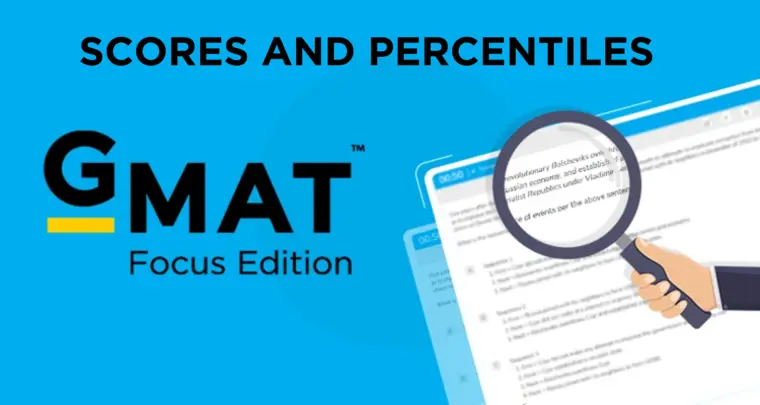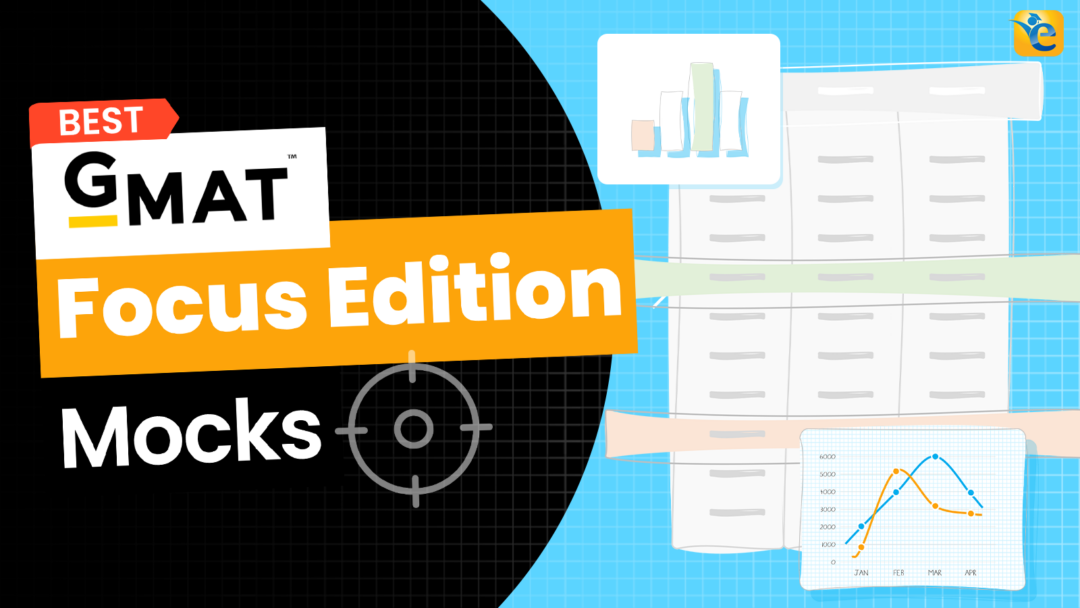The journey to business school begins with a critical decision: GMAT vs GRE? If you’ve found yourself staring at your computer screen, multiple browser tabs open, wondering “Should I take the GMAT or GRE?” – welcome to the club. The good news? This choice actually gives you leverage in the admissions process.
While admissions directors at top programs continually reassure applicants there’s “absolutely no preference” between tests, the question isn’t what THEY prefer – it’s about understanding the difference between GRE and GMAT to determine which test will make YOU shine brightest in a sea of qualified candidates.
Your Personalized Test Recommendation: GMAT or GRE?
Not sure whether to take the GMAT or GRE? Try our Personalised Test Recommendation Guide—answer a few simple questions, and get instant recommendations on choosing between GMAT and GRE based on your strengths and goals.
Taking a mock test is a crucial first step in deciding whether to prepare for the GMAT or GRE, as it sets a baseline and highlights your strengths and weaknesses.
Key Questions to Ask Yourself
Before diving into the detailed comparison, ask yourself these essential questions:
- What are your quantitative and verbal strengths? GMAT rewards logical reasoning and clever problem-solving, while GRE emphasizes vocabulary and straightforward math application.
- Are you aiming for top MBA programs? GMAT’s superior scoring system allows you to stand out in the crowded 95th+ percentile range.
- Are merit scholarships important to you? GMAT’s finer scoring scale may provide more opportunities to qualify for higher scholarship tiers, as small score improvements can translate to meaningful percentile jumps.
GMAT vs GRE: A Quick Comparison for Test-Takers
When deciding which is easier, GMAT or GRE, consider your personal strengths:
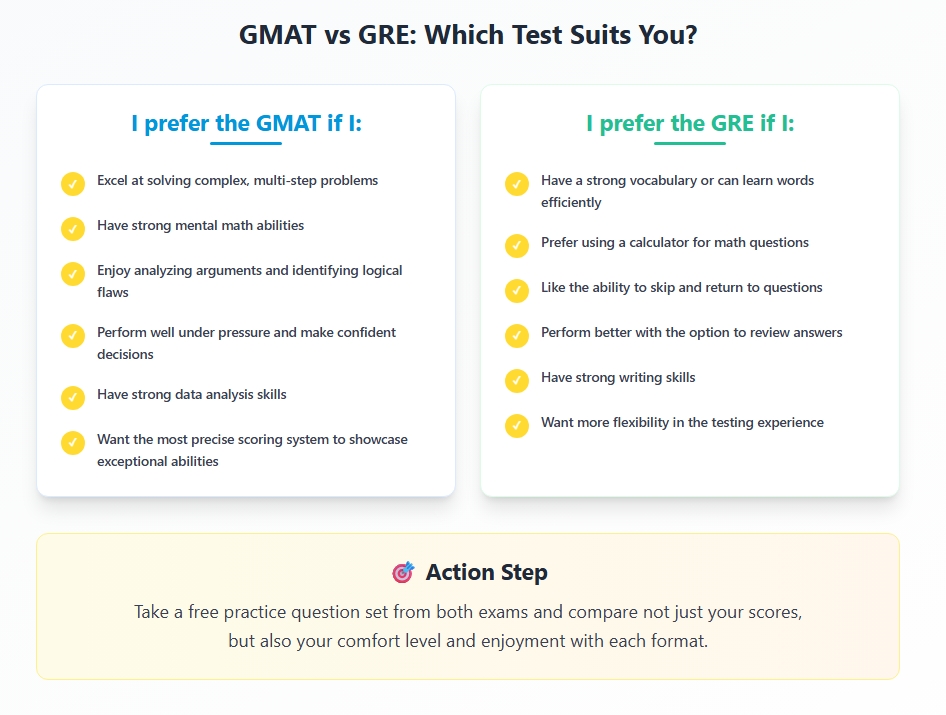
Watch this video to learn which test is right for you
- Your Personalized Test Recommendation: GMAT or GRE?
- GMAT vs GRE: A Quick Comparison for Test-Takers
- Business School Acceptance Trends: Do Schools Prefer GMAT or GRE?
- GMAT’s Scoring Advantage: Higher Resolution at the Top
- Scholarship Implications: How Your Test Choice Affects Financial Aid
- GMAT vs GRE – Which is easier?
- GMAT vs GRE Test Format and Structure: How Each Test Works
- GMAT vs GRE Preparation Strategy: Timeline and Resources
- Conclusion : Making Your Final Decision Between GMAT vs GRE
- Planning to take the GMAT?
- FAQs – GMAT vs GRE
Business School Acceptance Trends: Do Schools Prefer GMAT or GRE?
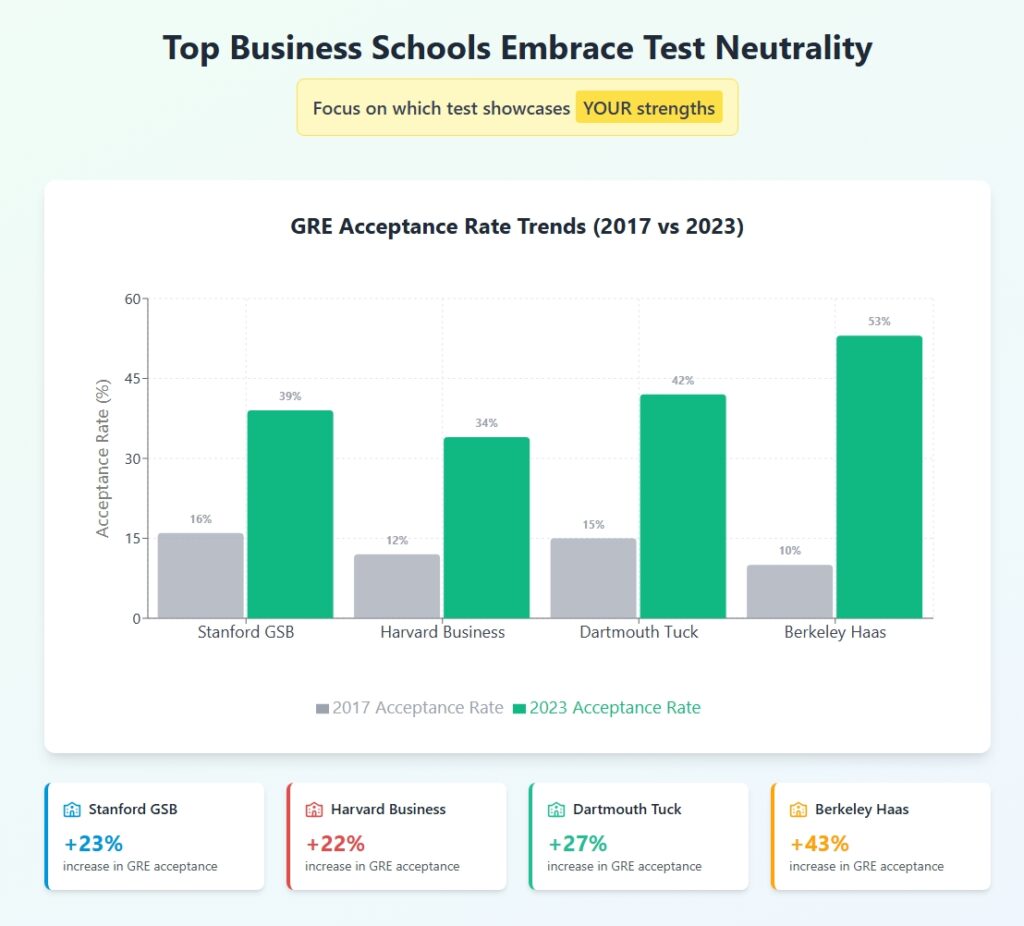
What Admissions Directors Say About GMAT vs GRE
The key fact you need to know: All top MBA programs now accept both GMAT and GRE scores with no official preference between them.
Harvard Business School, Wharton, Stanford, and other elite programs explicitly state they have “no preference” between the tests. As Dartmouth Tuck’s admissions director puts it: “We assess each applicant based on merit…there’s no hidden advantage in selecting one test over the other.”
GRE Acceptance Statistics at Top MBA Programs
While the GMAT remains more common overall, the GRE’s market share is growing rapidly:
- Harvard Business School: 41% of the MBA Class of 2026 admitted with GRE scores (up from 12% in 2018)
- Berkeley Haas: 53% of admits used GRE in 2023 – more than GMAT submissions
- Stanford, Wharton, Yale SOM: All seeing 35-40% GRE submission rates
What These Trends Mean for Your Application Strategy: With schools being genuinely test-neutral, you should focus on which test allows you to present your strengths most effectively, rather than which is better, GRE or GMAT, in general terms.
GMAT’s Scoring Advantage: Higher Resolution at the Top
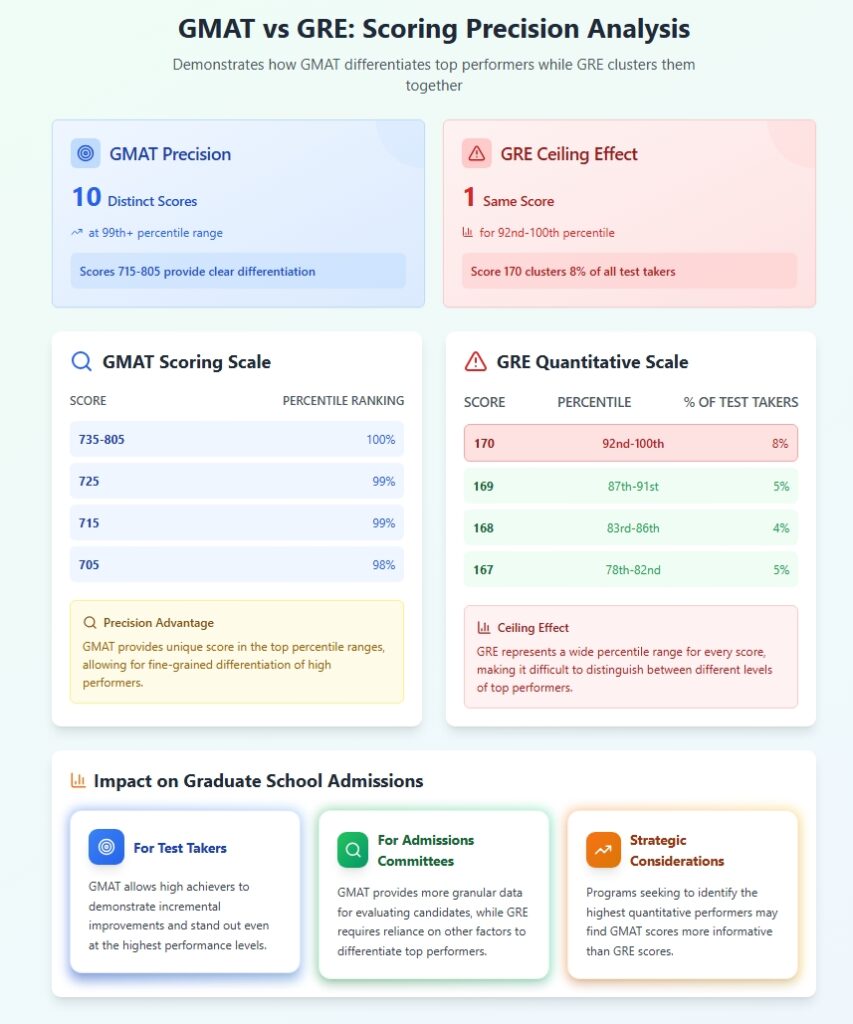
Understanding what is on the GMAT and what is on the GRE helps explain their different scoring approaches. Let’s examine how the unique scoring architectures of each test can impact your admissions outcomes and scholarship opportunities.
GMAT vs GRE: Basic Test Structure Comparison
Before diving into scoring differences, let’s understand the basic structure of each exam:
| Feature | GMAT | GRE |
| Sections | • Quantitative Reasoning • Verbal Reasoning • Data Insights | • Verbal Reasoning • Quantitative Reasoning • Analytical Writing |
| Scoring System | • Integrated scoring system • Overall score range: 205-805 • Individual section scores: 60-90 | • Section-based scoring system • Verbal and Quantitative: 130-170 each • Analytical Writing: 0-6 |
Key Insight: While both tests measure similar skills, their scoring systems differ significantly – especially at the top of the scale where competitive MBA applicants score.
GMAT’s Scoring Precision Advantage
The GMAT offers exceptional scoring precision at high performance levels. On a 205-805 scale, the GMAT provides:
- 10 distinct scores in just the 99th-100th percentile range (715-805)
- Clear differentiation between top performers
- More accurate reflection of your true abilities
Why This Matters: The GMAT can distinguish between excellent (705 – 98th percentile) and truly exceptional (725 – 99th percentile) performance, giving admissions committees more data points when comparing top candidates.
GRE’s Scoring Limitation: The Ceiling Effect

By contrast, the GRE’s scoring system has notable limitations at the high end. The GRE Quantitative section uses a 130-170 scale with 1-point increments, but the distribution creates a clustering effect among top performers.
Let’s examine the GRE Quantitative scoring:
- Perfect 170 in Quant = 92nd percentile
- 169 in Quant = 87th percentile
- 168 in Quant = 83rd percentile
This reveals two key limitations:
- No differentiation beyond 92nd percentile: Everyone from the 93rd to 100th percentile receives the same score (170).
- Large percentile bands share the same score: All test-takers between the 87th and 92nd percentiles receive a 169 in Quant.
Bottom Line: On the GRE, a truly exceptional performer (99th percentile) looks identical to a 93rd percentile performer on paper.
Take a FREE GMAT mock test to understand your baseline score and start your GMAT Focus prep with our free trial. With access to 10+ hours of AI-driven video lessons and 400+ practice questions, we provide a comprehensive resource for your GMAT Focus preparation. As the most reviewed online GMAT Prep company with 2700+ reviews on GMATClub.
Real Application Impact: How Scoring Differences Affect Admissions
Scenario: Three applicants with different ability levels:
| Applicant Profile | GMAT Score (Percentile) | GRE Quant Score (Percentile) |
| ⭐ Truly Exceptional | 725 (99th) | 170 (92nd+) |
| ⚡ Excellent | 705 (98th) | 170 (92nd+) |
| ✅ Very Strong | 685 (96th) | 169 (87th) |
On the GMAT, all three applicants receive distinct scores that accurately reflect their different abilities. On the GRE, the top two receive identical scores, obscuring meaningful differences
Strategic Advantage: Why Small Improvements Matter More on GMAT
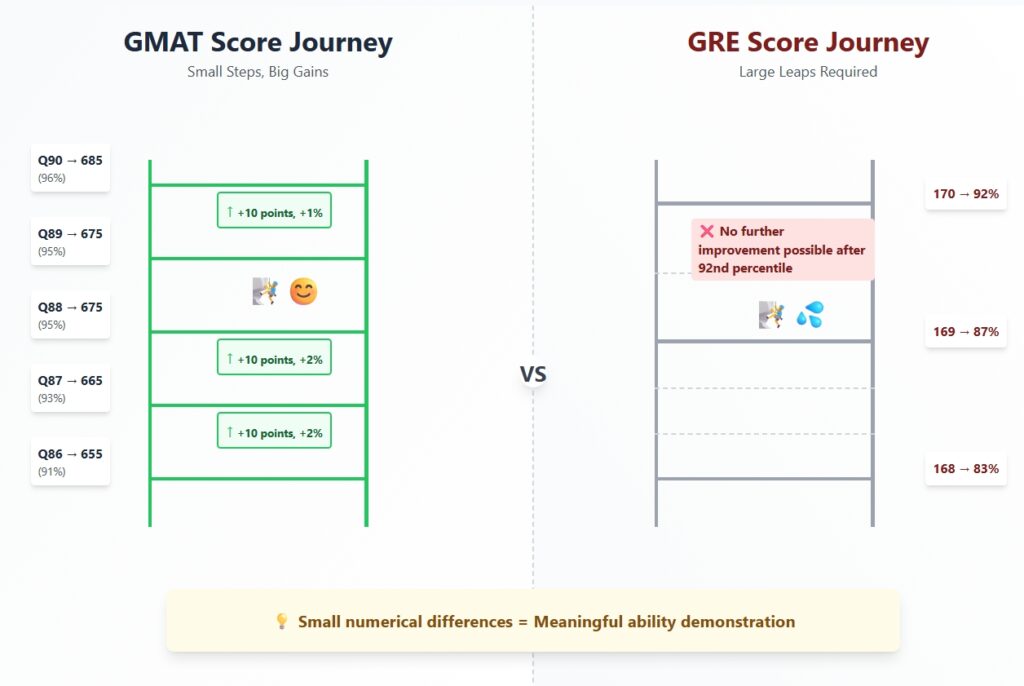
The GMAT rewards incremental improvement more visibly:
- GMAT: Improving your Quant score from 86 to 87 (one point) boosts your percentile from 91st to 94th – a meaningful 3 percentile gain that can significantly impact how your application is perceived.
- GRE: You’d need to jump from a 169 to a perfect 170 in Quant to move from the 87th to the 92nd percentile – and if you’re already at 170, you cannot demonstrate further improvement.
Key Insight: “The difference between a 705 and a 725 GMAT might seem small numerically, but it represents a meaningful difference in demonstrated ability that admissions committees can use in their holistic review.
Learn more about GMAT score percentiles and what they mean for your application
Scholarship Implications: How Your Test Choice Affects Financial Aid
Your test choice can have significant financial implications beyond just admissions outcomes. Many business schools use test scores as a key factor in awarding merit-based scholarships, and the scoring differences between GMAT and GRE can directly impact your scholarship opportunities.
Schools often set specific score thresholds or bands for scholarship consideration, with higher scores qualifying for larger awards.
Consider this scenario: A business school might allocate scholarships based on these percentile bands:
| Score Percentile | Scholarship Range |
| 99th percentile | $40,000-$60,000 |
| 96th-98th percentile | $20,000-$40,000 |
| 90th-95th percentile | $10,000-$20,000 |
With the GMAT’s granular scoring, you can get a score to distinguish yourself at every level. Even a 10-20 point improvement can potentially translate to thousands of additional scholarship dollars.
On the GRE, with fewer distinct score levels at the top range, it can be harder to distinguish between candidates who might otherwise qualify for different scholarship amounts.
Note: This is a simplified example to showcase the impact of granularity on decisions like scholarships. However, scholarships decisions are more layered than this and involve consideration of several factors beyond scores.
Why GMAT’s Scoring System Creates Scholarship Advantages
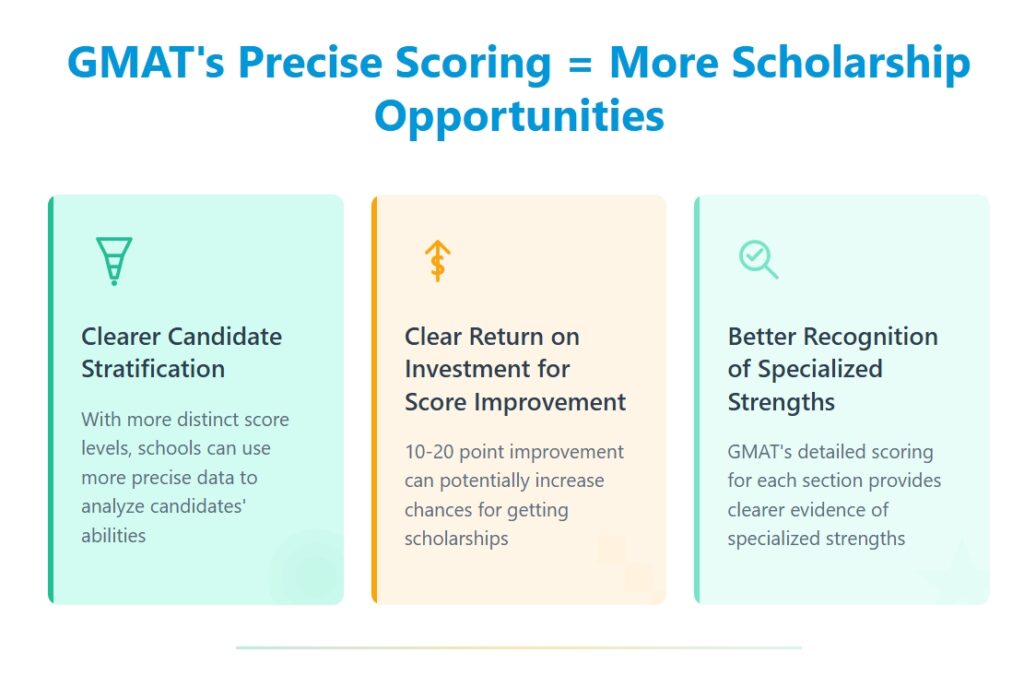
The GMAT’s precise scoring creates more opportunities for scholarship differentiation. Here’s how:
- Clearer candidate stratification: With more distinct score levels, scholarship committees can use more precise data to analyze candidates’ strengths and their qualification for different tiers of funding. This benefits applicants by providing more opportunities to qualify for higher scholarship bands.
- Clear Return on Investment for Score Improvement
- GMAT: A 20-point improvement (achievable with focused study) can potentially increase scholarship offers by $10,000+
- GRE: Moving from one score band to another often requires larger, more difficult improvements
- Better Recognition of Special Strengths
- Some schools offer specialized scholarships for exceptional performance in specific areas (e.g., quantitative excellence)
- GMAT’s detailed section scoring provides clearer evidence of these specialized strengths
Bottom Line: If merit scholarships are a significant factor in your decision, the GMAT’s precise scoring system may offer better opportunities to demonstrate your exact ability level and qualify for higher scholarship amounts.
GMAT vs GRE – Which is easier?
The GMAT and GRE test similar skills but in substantially different ways. Understanding these differences is crucial for choosing the test that will showcase your unique strengths and determining which is easier, GMAT or GRE, for your specific abilities
GRE vs GMAT – Quantitative Section Comparison
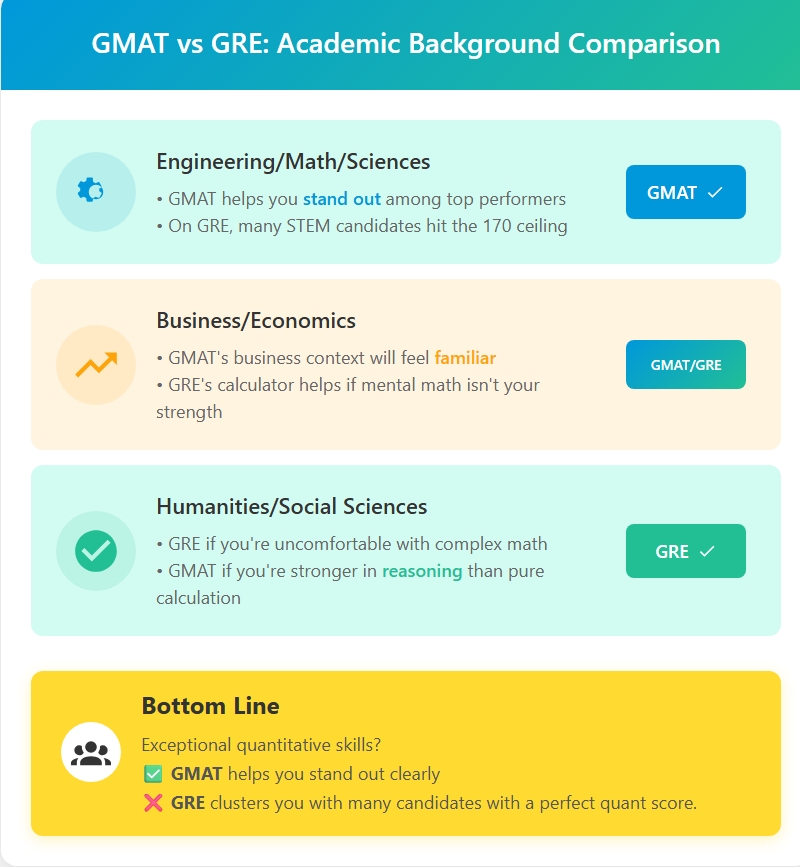
Quick Comparison: Which Math Test Suits You Better?
| Feature | GMAT Quant | GRE Quant | Your Advantage |
| Question Format | Problem-solving with multi-step reasoning | More straightforward, formula-based problems | GMAT: If you enjoy puzzles GRE: If you prefer direct application |
| Calculator Use | No calculator allowed | On-screen calculator provided | GMAT: If you’re strong at mental math GRE: If you rely on calculation tools |
| Time Per Question | 2.1 minutes | 1.7 minutes | GMAT: If you prefer fewer, deeper problems GRE: If you work quickly through problems |
| Content Emphasis | Business-logic puzzles | Broader mathematical concepts | GMAT: If you like analytical challenges GRE: If you prefer traditional math |
GMAT Quant now contains only Problem-Solving questions whereas GRE Quant is an assortment of Quantitative Comparison, Problem Solving, and Data Interpretation questions.
Sample GMAT Question : Quantitative
Q: A certain airline’s fleet consisted of 60 type A planes at the beginning of 1980. At the end of each year, starting with 1980, the airline retired 3 of the type A planes and acquired 4 new type B planes. How many years did it take before the number of type A planes left was less than 50% of the total fleet?
Options:
- 6
- 7
- 8
- 9
- 10
Source: Official GMAT practice question (problem solving).
Answer: : 9 years
Explanation :This GMAT quant question involves a word problem with simple arithmetic progressions. It tests the ability to model an evolving situation year by year. You could solve it algebraically or by logical iteration. A quick approach (as the official explanation notes) is to “back-solve” using the answer choices. Try 8 years: 60 – 8(3) = 36 A planes left, and 8(4) = 32 B planes; total 68 planes, of which A = 36 (just over 50%). Try 9 years: 60 – 9(3) = 33 A, and 9(4) = 36 B; total 69, A = 33 which is <50% of 69. So 9 is the first year A falls below half. This kind of problem is not extremely hard math; the GMAT is testing whether you choose an efficient strategy and avoid mistakes. At 700+ level, GMAT quant often presents questions where picking the right approach (back-solving, clever logic, etc.) is crucial.
Sample GRE Question : Quantitative
Q: In how many different ways can 3 identical green shirts and 3 identical red shirts be distributed among 6 children such that each child receives a shirt?
Source: GRE practice question.
Answer: 20 ways
Explanation: This GRE quant question tests combinatorics in a simple way. We have 6 indistinguishable green shirts and 6 kids – effectively, choose which 3 of the 6 kids get the green shirts (the rest will get red). Since the shirts of each color are identical, it’s just the number of subsets of 3 kids out of 6 to assign green shirts, which is “6 choose 3” = 20. The GRE often includes combinatorics, probabilities, or comparisons that are conceptually straightforward if you know the formulas, but can trip you up if you misinterpret. Here, recognizing it as a combinations problem yields the answer quickly.
How Your Academic Background Influences Your Math Test Fit:
| Academic Background | Better Test Fit | Why It’s a Better Match |
| Engineering/Math/Sciences | GMAT if you have exceptional quant skills GRE if you want to focus energy on verbal | ✅ GMAT allows you to stand out even among other strong quant performers ✅ On GRE, many STEM candidates hit the 170 ceiling |
| Business/Economics | GMAT if you’re comfortable with analytical reasoning GRE if you prefer straightforward application | ✅ GMAT’s business context will feel familiar ✅ GRE’s calculator helps if mental math isn’t your strength |
| Humanities/Social Sciences | GRE if you’re uncomfortable with complex math GMAT if you’re stronger in reasoning than pure calculation | ✅ GRE’s straightforward approach is more accessible ✅ GMAT allows verbal strengths to compensate for quant weaknesses |
An interesting nuance is in the scoring: GMAT’s curved scoring means you can miss several questions and still achieve an excellent score because the questions are inherently more difficult. With GRE quant, however, candidates with strong math backgrounds often hit the ceiling score of 170, creating less differentiation at the top end.
Verbal Section: Finding Your Language Strength Sweet Spot
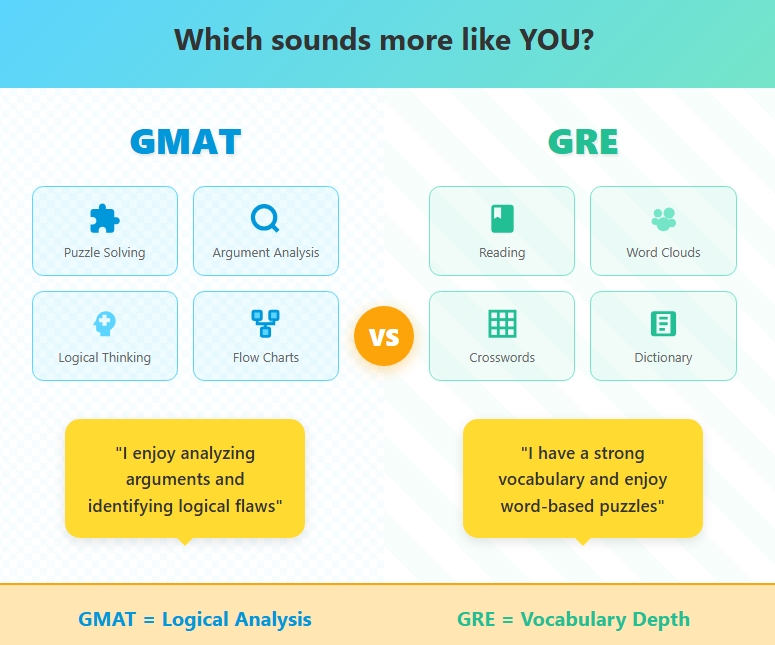
Quick Comparison: GRE vs GMAT Verbal Section
| Feature | GMAT Verbal | GRE Verbal | Your Advantage |
| Question Types | Reading Comprehension Critical Reasoning | Text Completion (vocabulary) Sentence Equivalence (synonyms) Reading Comprehension | GMAT: If you’re strong at logical analysis GRE: If you have strong vocabulary |
| Core Skills Tested | Argument analysis Logical reasoning Reading complex material | Vocabulary knowledge Context understanding Reading comprehension | GMAT: If you enjoy debate/logic GRE: If you’re well-read with strong vocabulary |
| Challenge Level | Complex arguments with nuanced reasoning | Advanced vocabulary in context | GMAT: If English is your native language GRE: If you’ve studied English vocabulary extensively |
Sample GMAT Question : Critical Reasoning
Q: A new machine for harvesting corn will allow rows to be planted only fifteen inches apart, instead of the usual thirty inches. Corn planted this closely will produce lower yields per plant. Nevertheless, the new machine will allow corn growers to double their profits per acre because ________
Options :
- with the closer spacing of the rows, the growing corn plants will quickly form a dense canopy of leaves, which will, by shading the ground, minimize the need for costly weed control and irrigation
- with the closer spacing of the rows, corn plants will be forced to grow taller because of increased competition for sunlight from neighboring corn plants
- with the larger number of plants growing per acre, more fertilizer will be required
- with the spacing between rows cut by half, the number of plants grown per acre will almost double
- with the closer spacing of the rows, the acreage on which corn is planted will be utilized much more intensively than it was before, requiring more frequent fallow years in which corn fields are left unplanted
Source: Official GMAT practice question
Correct answer: option 1, which highlights cost savings that, combined with more plants, outweigh the lower yield per plant)
Explanation : This Critical Reasoning question exemplifies GMAT logic: you must complete the argument by finding the assumption or reason that reconciles a seeming contradiction (closer spacing gives lower yield per plant, yet doubles profit per acre). The GMAT rewards careful analysis of the argument’s structure. Many test-takers might be tempted by option 4 (“number of plants…will almost double”) because it’s intuitive, but that was a trap – it doesn’t account for the lower yield per plant. The correct answer involved a less obvious factor (reduced costs) that, when combined with more plants, doubles profitThis shows how GMAT CR tests your critical thinking and ability to avoid logical traps.
Sample GRE Question : Text Completion
Q: Given that Hefele was obviously sophisticated and worldly, his failure to do well in the position can hardly be ascribed to ________
Options:
A. callowness
B. unintelligence
C. sloth
D. cupidity
E. incompetence
Source: Official GRE Text Completion practice
Correct answer: A. callowness, meaning immaturity or lack of experience
Explanation : This GRE verbal question is all about finding the word that fits the sentence’s logic, and it hinges on vocabulary knowledge. The sentence suggests that because Hefele was sophisticated and worldly, his failure can’t be blamed on something. You need an opposite of “sophisticated/worldly.” The correct answer was “callowness”, which means youth and inexperience – essentially NOT worldly. Many people struggle if they don’t know the word callow. The other choices are easier words (“sloth” = laziness, “cupidity” = greed, etc.), which you can eliminate if you know their meanings (e.g. his failure wouldn’t be attributed to greed or laziness given he’s described as sophisticated). This example highlights the GRE’s focus on precise vocabulary; the test often requires picking a single right word out of several high-level synonyms. If you didn’t know callowness, you’d have to guess – underscoring why GRE prep involves a lot of vocab building.
Bottom Line: The GRE rewards vocabulary depth and breadth, while the GMAT rewards logical analysis and critical thinking. Consider which verbal skills you can most easily demonstrate.
Unique Test Sections: Data Insights vs Analytical Writing

Each test includes a distinctive section that tests different skill sets:
GMAT Data Insights (DI):
- 20 questions analyzing charts, graphs, tables and other data
- Tests business-relevant data interpretation skills
- Scored as part of your total GMAT score
- Calculator allowed
- Highly relevant for data-driven business roles
GRE Analytical Writing:
- 30-minute essay analyzing an issue
- Tests your ability to construct and articulate complex arguments
- Scored separately from main sections (0-6 scale)
- Demonstrates communication and critical thinking skills
- Relevant for roles requiring written communication
Professional Background Alignment:
| Professional Background | Section Alignment | Strategic Consideration |
| Consulting/Finance/Data Analysis | Strong GMAT DI fit | Showcases directly relevant business analysis skills |
| Marketing/Communications | Strong GRE Analytical Writing fit | Demonstrates persuasive writing abilities |
| Engineering/Technical | Likely strong GMAT DI fit | Data analysis skills transfer well |
| Education/Non-profit | Often strong GRE Analytical Writing | Written communication is typically a strength |
Strategic Consideration: Think about your broader application narrative. The GMAT Data Insights section can help technical candidates demonstrate business readiness, while the GRE AWA can help humanities candidates showcase communication skills that might otherwise be questioned.
Comparing the exams: you can see the GMAT questions emphasize reasoning (figuring out a puzzle or logic in the argument, or deciding a strategy to solve a problem), whereas the GRE questions rely on knowing the meaning of words or applying a formula (with less trickery). Of course, both exams include a mix, but the balance differs. The GMAT’s format (e.g. Data Sufficiency questions in Data Insight, which we didn’t show here) often demands deeper thought about what information is needed, while the GRE’s hallmark is knowing a breadth of vocabulary and math concepts but in a more direct question style.
GMAT vs GRE Test Format and Structure: How Each Test Works
The tests’ different adaptive structures create very different experiences:
| Feature | GMAT: Question-Adaptive | Median GRE (V/Q) |
| Adaptation Level | Adjusts difficulty after each question | First section of medium difficulty, second section adjusts based on performance |
| Answer Review | Cannot review or change answers (except 3 allowed in Focus Edition) 73% | Can review and change answers within a section |
| Question Navigation | Each question impacts subsequent difficulty | Freedom to skip questions and return later |
| Rewards/Favors | Decisiveness, confidence, consistency, pressure performance | Strategic approach, careful review, flexibility |
GMAT vs GRE Preparation Strategy: Timeline and Resources
Preparing for either exam requires significant time investment, but the duration and focus areas differ based on the GMAT and GRE syllabus components.
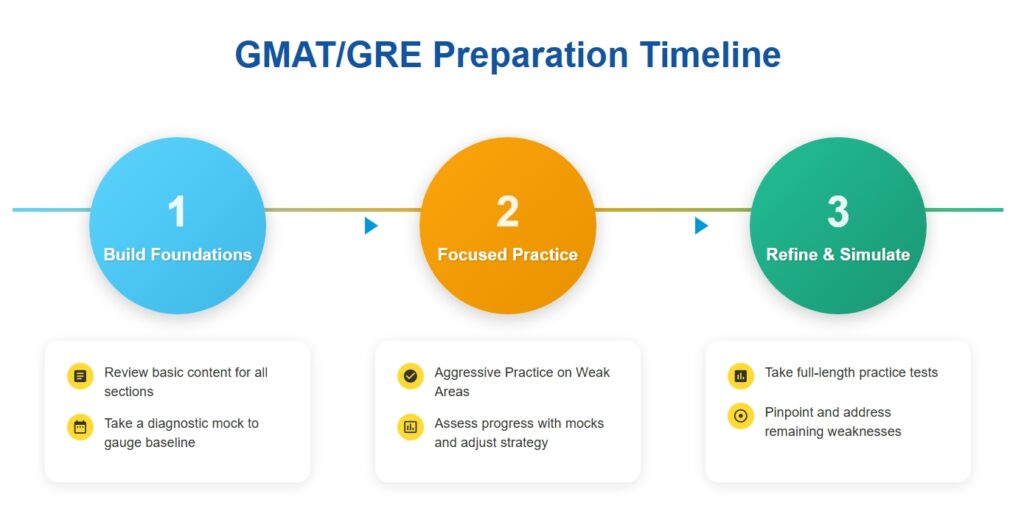
GMAT vs GRE: Study Time Investment & Preparation Requirements
| Exam Preparation | GMAT | GRE |
| Total Study Hours | Median for 700+ scorers: ~90 hours High scorers: 90-120 hours | Typical range: 50-200 hours |
| Recommended Study Period | 3 months (approx. 10 hours/week) 2.5-3.5 months for high scorers | 1-3 months for most candidates |
| Background-Based Variations | Over half of test-takers study 50+ hours (GMAC surveys) | Strong backgrounds: 4-6 weeks (40-60 hours) Long time since school: 4-5 months (150+ hours) |
| Unique Learning Challenges | Requires learning unique question formats: • Data Sufficiency • Critical Reasoning • Unfamiliar formats requiring dedicated practice | Significant vocabulary component: • Many students spend weeks learning hundreds of high-frequency GRE words • Time-consuming process not required for GMAT |
Suggested 3-Month Timeline:
Month 1 (Weeks 1-4): Build Foundations
- Review basic content for both quant and verbal sections
- For GRE: Begin systematic vocabulary study (30-50 new words per week)
- For GMAT: Review problem-solving techniques and critical reasoning basics
- Take a diagnostic practice test by end of month to gauge baseline
Month 2 (Weeks 5-8): Focused Practice and Technique
- Solve lots of practice questions, focusing on weak areas
- For GRE: Increase vocabulary difficulty and practice Text Completions
- For GMAT: Master Data Sufficiency and Critical Reasoning patterns
- Take a mid-point practice test to check progress and adjust strategy
Month 3 (Weeks 9-12): Refine and Simulate
- Take at least 2 full-length practice tests
- Pinpoint and address remaining weaknesses
- Practice time management under test conditions
- In final week, lighten study load and review key concepts
Candidates with weaker backgrounds in quant or verbal might extend to 4-6 months prep; others may condense to 8 weeks if already strong – adjust the timeline as needed.
Conclusion : Making Your Final Decision Between GMAT vs GRE
When deciding between the GMAT and GRE, remember these critical factors:
- Admissions Reality: All top MBA programs accept both tests with no official preference. Harvard now admits 41% of students with GRE scores, while Berkeley Haas is at 53%.
- Scoring Differences: The GMAT offers greater scoring precision at high levels with 10 distinct scores in the 99th-100th percentile range, while the GRE has a “ceiling effect” where top performers cluster at the same scores.
- Format Alignment: Your personal strengths and testing style matter more than which test is “better.” The GMAT rewards analytical reasoning and decisive test-taking, while the GRE favors strong vocabulary and a more flexible approach.
- Scholarship Impact: Test choice can affect merit scholarship opportunities, with the GMAT’s precise scoring potentially providing clearer differentiation for scholarship tiers.
Actionable Next Steps
- Establish your baseline with a practice test for your chosen exam
- Create a 2-3 month study plan focusing on your specific areas for improvement
- Practice strategically with full-length tests every 2-3 weeks
- Schedule your test at least 6 months before application deadlines, allowing time for a retake if needed
Remember that your test score is just one component of your business school application. By choosing the test that aligns with your personal strengths, you position yourself for the strongest possible performance and success in the competitive admissions process.
Best of luck with your business school journey!
Planning to take the GMAT?
If you are planning to take the GMAT, we can help you with a personalized study plan and give you access to quality online content to prepare for GMAT Focus Edition. Write to us at acethegmat@e-gmat.com.
Take a FREE GMAT mock test to understand your baseline score and start your GMAT prep with our free trial. With access to 10+ hours of AI-driven video lessons and 400+ practice questions, we provide a comprehensive resource for your GMAT preparation. As the most reviewed online GMAT Prep company with 2800+ reviews on GMATClub, we’re committed to helping you succeed.
FAQs – GMAT vs GRE
Neither test is universally “harder” – they’re simply different. The GMAT challenges logical reasoning and analytical skills, while the GRE tests vocabulary and more straightforward math application. Your background and strengths will determine which feels more difficult for you.
The GMAT rewards those who excel at solving complex, multi-step problems and analyzing complex arguments whereas the GRE appeals to those with strong vocabulary and who prefer using a calculator. Rather than asking which is harder, consider which test aligns better with your personal strengths.
Your test choice can significantly impact scholarship opportunities at business schools.
The GMAT’s granular scoring system provides a distinct advantage here. With 10 distinct scores in just the 99th-100th percentile range, the GMAT offers clearer differentiation between top performers. On the GRE, with fewer distinct score levels at the top range, it’s harder to differentiate between candidates who might otherwise qualify for different scholarship amounts.
If merit scholarships are a significant factor in your decision, the GMAT’s precise scoring system may provide better opportunities to qualify for higher amounts.
For quant-heavy programs, the GMAT generally provides better differentiation of exceptional quantitative abilities. The GMAT Quant section tests multi-step reasoning and problem-solving, allowing truly talented quantitative thinkers to stand out.
The key advantage lies in the GMAT’s scoring precision. On the GRE, a perfect 170 in Quant represents only the 92nd percentile, meaning everyone from the 93rd to 100th percentile receives the same score. This creates a “ceiling effect” where many strong STEM candidates cluster at the maximum score, making differentiation impossible.
The GMAT’s finer scoring scale allows for better recognition of exceptional talent, with distinct scores available even at the highest performance levels.
For those with engineering or mathematical backgrounds, the GMAT provides better opportunities to demonstrate how your quantitative abilities compare to other strong performers, while on the GRE, you might be one of many candidates with a perfect quant score.
No, top MBA programs have no official preference between the GMAT and GRE. All elite business schools now accept both tests equally, and admissions directors at Harvard, Stanford, Wharton, and other top programs explicitly state they have “no preference” between them.
The data confirms this neutrality. The GRE’s market share is growing rapidly at elite programs.
With schools being genuinely test-neutral, your focus should be on which test allows you to present your strengths most effectively, rather than trying to guess which test a particular school might prefer.
The GMAT and GRE differ significantly in both content and format:
Content Differences:
GMAT Quantitative: Complex problem-solving without a calculator, business-oriented logic puzzles, 2.1 minutes per question
GRE Quantitative: More straightforward, formula-based problems with an on-screen calculator, 1.7 minutes per question
GMAT Verbal: Focus on critical reasoning and argument analysis
GRE Verbal: Heavy emphasis on vocabulary through Text Completion and Sentence Equivalence questions
Unique Sections: GMAT has Data Insights (analyzing business data); GRE has Analytical Writing (essay construction)
Format Differences:
GMAT: Question-adaptive format that adjusts difficulty after each question; cannot review or change answers (except 3 allowed in Focus Edition)
GRE: Section-adaptive format; entire first section of medium difficulty, second section adjusts based on performance; can review and change answers within sections
These structural differences create distinct experiences: GMAT rewards decisiveness and performance under pressure, while GRE rewards strategic approach and careful review. Your personal testing style and strengths should guide which format will help you perform your best.
The GMAT and GRE create distinctly different experiences regarding anxiety and time pressure, largely due to their structural differences:
The GMAT’s question-adaptive format, which prohibits reviewing previous answers (except 3 allowed in Focus Edition), creates higher immediate pressure. Each question directly affects subsequent difficulty, requiring confident, decisive responses.
The GRE’s section-adaptive format allows reviewing and changing answers within each section, creating a more flexible experience.
Your personal testing style can impact your score by 20-50 points regardless of your knowledge level.
The best test for your MBA application depends on your personal strengths and goals. Consider these factors:
Choose the GMAT if you:
Excel at logical reasoning and analytical thinking
Have strong mental math abilities without a calculator
Perform well under pressure with irreversible decisions
Want the most precise scoring system to distinguish yourself at high performance levels
Are targeting merit scholarships where small score differences matter
Have a business or consulting background that aligns with the GMAT’s analytical focus
Choose the GRE if you:
Have strong vocabulary skills or can learn words efficiently
Prefer using a calculator for math questions
Like the ability to review and change answers within sections
Have a humanities or non-traditional background
Want to keep options open for non-business graduate programs
Feel more comfortable with a more flexible testing experience
If you’ve been out of school for several years, your choice between GMAT and GRE should factor in both your current skillset and professional experience:
The GMAT may be advantageous if:
Your professional experience involves business analysis, problem-solving, or data interpretation
You’ve maintained strong analytical reasoning skills through your work
You want to leverage the GMAT Data Insights section to showcase business-relevant skills developed in your career
The GRE might be preferable if:
You’re rusty on mental math and would benefit from calculator access
Your vocabulary has remained strong or improved through professional communication
You prefer a more flexible test structure that allows reviewing answers
You can learn more about the structure of both the exams and which one is more suitable based on your strengths.
While there is no direct official conversion table, understanding the scoring systems of both tests helps contextualize equivalencies:
The GMAT uses an integrated scoring system (205-805 scale) where:
725 represents the 99th percentile
705 represents the 98th percentile
685 represents the 96th percentile
The GRE uses separate Verbal and Quantitative scores (130-170 each) where:
170Q represents the 92nd percentile
169Q represents the 87th percentile
168Q represents the 83rd percentile
A key insight is that the GRE experiences a “ceiling effect” – everyone from the 93rd to 100th percentile receives the same Quant score (170), making fine distinctions impossible at the high end.
For accurate conversions, we recommend using the official ETS GRE to GMAT comparison tool. Remember that percentiles are generally more important than raw scores, and schools are familiar with interpreting both testing systems.
Switching from GMAT to GRE presents both challenges and opportunities based on the tests’ different structures and content focuses:
Aspects that make switching easier:
Reading comprehension skills transfer directly between tests
Basic quantitative concepts are tested on both exams
The GRE’s calculator availability may feel like a relief after GMAT’s mental math
The GRE’s ability to review and change answers might feel more comfortable
Challenges when switching:
GRE requires significant vocabulary study not needed for GMAT (potentially weeks learning hundreds of words)
Different time management strategies are required for section-adaptive vs. question-adaptive formats
The GRE’s Text Completion and Sentence Equivalence questions have no GMAT equivalent
Adjusting from GMAT’s logical reasoning focus to GRE’s vocabulary emphasis
When switching, most test-takers need 2-4 weeks to adapt to the format differences. The preparation timeline suggests dedicating specific time to GRE-specific question types and vocabulary building.
If you’ve taken both tests, submit the score that presents you in the strongest light, considering these factors:
Percentile performance: Compare the percentiles rather than raw scores. A 720 GMAT (95th percentile) generally looks stronger than a 325 GRE (85th percentile), even though both are good scores.
Score balance: Schools value balanced performance. If your GMAT shows significantly stronger quantitative skills but weaker verbal (or vice versa), while your GRE shows more balance, the GRE might present you better.
Alignment with strengths: If your professional narrative emphasizes analytical thinking, a strong GMAT score reinforces this story. If you’re highlighting communication skills, a strong GRE Verbal score might be more relevant.
Scholarship considerations: The GMAT’s finer scoring scale might provide advantages for merit scholarship consideration at some schools.




